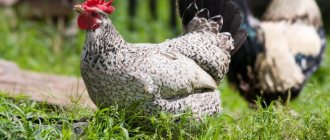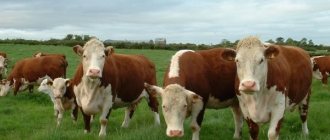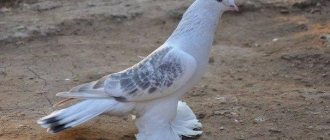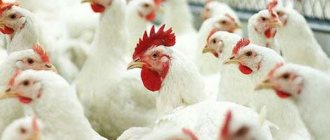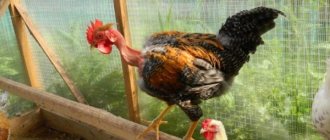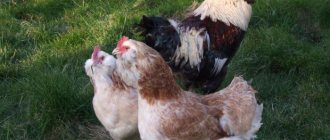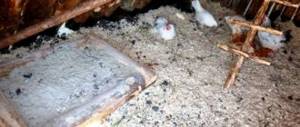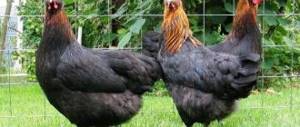Description and features of the Dutch cow
This breed of cows is famous for its milk, because the lactation period lasts 300 days or more. During this period, you can milk 6000 liters of milk with a fat content of 4.1%. In addition to high milk yields, these cows can also produce a significant amount of meat; one carcass produces 58% of the meat by weight.
The Dutch have undergone intensive development over the last 160 years. At first, the cows had weak muscles, weak bones, and thin skin. Today, the cows have become stronger, their bones have become strong, and their muscles have become strong. This had a positive effect on both their health and the taste of the meat.
The color of the Dutch cow is black and white, motley, the body is elongated. The head is long, the forehead is narrowed. This type of cow is hornless. Signs of a meat breed:
- not long legs;
- back straight;
- the sides are wide.
The ischial tuberosities and shoulder blades protrude above the body, and the lower back is wide. The udder is large, where the vessels protrude well.
The height of a Dutch cow reaches 132 centimeters, the weight of one animal is at least 600 kilograms, bulls reach 1 ton. Calves of beef breeds are born with a large weight - 40-42 kilograms of live weight.
The breed is a fast-maturing animal; calves quickly gain weight and develop well. Already at six months, the heifer weighs almost 200 kilograms, and the bulls about 300 kilograms. At one and a half years the heifer is ready to bear her first calf. She should be taken to mating, but if this is not possible, then artificial insemination is carried out. Bulls are ready to inseminate a heifer a little earlier; for them this happens at 1 year and 3 months.
These cows are very shy, they are afraid of extraneous noises, veterinary examinations and vaccinations. If the Dutchman is very frightened, then for a certain time milk production may decrease and appetite may disappear.
Animals are finicky to keep, they cannot be kept on a leash, so they experience stress. Cows love freedom, so they need to be kept in a spacious stall.
Soviet breeds
In the USSR, the issue of breeding was approached comprehensively and experimented widely and on a large scale. Local groups crossed with foreign ones. The result was a wide variety of breeds.
Be sure to read this: Belgian bull, beef breed of cows: maintenance, benefits, where to buy
Kazakh white-headed
Kazakh white-headed breed of cows
Adapted to harsh conditions and improved offspring from crossing Hereford cows with our domestic ones. Bulls weigh 850 kg, cows - 500.
Individuals easily gain weight on pastures with sparse vegetation and are more resilient than any European breed. Ideal for private owners. Fertile, offspring survival rate is up to 96%. Do not require special care.
An exclusively meat line produces 1.5 tons of milk per year, and a universal line produces up to 2.5 tons. The dairy Kazakh Whitehead is a meat breed, but is capable of providing small volumes of milk for personal needs.
Ukrainian meat
It appeared as a result of crossing the Shirolese and Simental breeds with Ukrainian cows. The pedigree also includes Kian cows. Ukrainians easily gain weight on pasture and are able to feed on a wide variety of plants.
The bulls are very large - up to one and a half meters at the withers, some weigh up to 1200 kg. Females are smaller – 135 cm and 560 kg, respectively. They are distinguished by a solid meat yield: 50-64%. Animal skin is valuable and is used to make shoes and accessories.
The breed was officially recognized in 1993. Despite its positive qualities, it is rare on farms; the total number is approximately 10 thousand heads.
Volynskaya
Volyn breed of cows
A breed from Ukraine, registered in 1994. A cross between many breeds: Limousin, Aberdeen Angus, Hereford, Polish Red and Black Pied.
Individuals of red color: coat color varies from dark to red. Bulls weigh a ton, cows are half that weight. Meat yield – 60-66%.
Kalmyk cows
Kalmyk breed of cows
fatten and gain weight very quickly. The calf's weight gain is up to one kilogram per day. The weight of bulls ranges from 600 kg to 1.1 tons.
Slaughter yield – 55-65%. The meat is juicy, interspersed with fat. Individuals are distinguished by their ability to grow on a meager food supply. They are not afraid of the sun, can stay on pasture for a long time, and are resistant to cold.
Be sure to read this: Holstein cow breed in Russia: description, how much milk it produces, productivity, how much it costs
Red meadow, or Mensco-Anjou, cow
Red meadow, or Mensco-Angevin, cow
. Bulls grow up to 170 cm at the withers, weigh almost 2 tons, cows are smaller. The breed is unpretentious in maintenance, individuals are adapted to pastures. Eating roughage is not a problem for them
The weight gain is very intense. Good milk yield indicators. Prolific, the survival rate of young animals is high.
Znamenovskaya meat breed
Znamenovskaya beef breed
In the steppe zones you can find these medium-sized cows. This means that the breed is undemanding when it comes to plant foods. She is not afraid of arid climates. She doesn’t care about winds, low temperatures, long stays on pastures and frequent migrations.
The fur is brown or black and white. The body is long, with well-developed muscles. Another characteristic feature is a large udder. Individuals weigh on average about 700 kg. Calves grow quickly, adding up to a kilogram of body weight every day.
Sources used:
- https://goferma.ru/zhivotnovodstvo/korovy/gollandskaya-poroda-korov.html
- https://poferme.com/zhivotnye/korovy/poroda/molochnye/gollandskaya.html
- https://ukr-shinshilla.com.ua/informacija-k-svedeniju/gollandskaja-poroda-korov.html
- https://fermilon.ru/hozyajstvo/zhivotnovodstvo/porody-bykov.html
- https://stroy-podskazka.ru/korovy/samye-bolshie/
- https://ferma.expert/jivotnie/krs/porody/gollandskaya-poroda-korov/
- https://gusiyabloni.com/zhivotnye/skot/vid/bychki-golshtinskoj-porody.html
- https://zverovod.info/byki/porody-myasnoi-napravlennosti.html
- https://stroy-podskazka.ru/korovy/porody/gollandskaya/
- https://domaferma.com/krupnyy-rogatyy-skot/porody-rogatogo-skota/masnye-porody-korov.html
How to care for Dutchies?
Livestock will not require any special attention and care; it is only important to follow the basic rules:
- maintaining cleanliness: cleaning the stall twice a day, replacing bedding, washing feeders and water containers;
- diet: cows must be fed three times a day, preferably at the same time;
- if milking occurs at the same time, then more milk production can be obtained;
- should be fed with vegetables and clean hay;
- the water should not be cold, its temperature can reach +16 degrees;
- the general temperature of the barn should be +10 degrees Celsius;
- To prevent unpleasant odors from entering the room, it must be systematically ventilated.
Before milking a cow, it is necessary to carefully examine the udder for mastitis, since the Dutch are very susceptible to this disease. It is also useful for cows of this breed to be vaccinated against mastitis.
Before purchasing a cow of a certain breed, they take into account the important point to which climate they are adapted. As for the Dutch, they love a temperate climate. Because cattle have a large rumen, they can process large quantities of lush green grass.
At 1 year and 3 months, bulls are sent for fattening, which lasts three months; it is during this period that they reach a weight of 300 kilograms. When the bull reaches 750 kilograms, they are taken to slaughter.
In order for the milk yield to be high, animals should be kept without a leash, where each animal has a box. That is, the room must be equipped with boxes where the animal can rest if desired. Cows are divided into several groups:
- non-milking;
- milking;
- deadwood.
Each group contains from 20 to 40 cows. If there is free space, cows in the last stage of pregnancy are kept separately. Calves should also be kept separate from everyone else. At first, the animals may clash until they find a common language.
Origin story
Photo:
The breed was bred in the USSR in the 1930s and 1940s. as a result of crossing bulls imported from Holland with cows of local breeds.
Also black and white cattle in 1930-1932. imported from Germany and the Baltic states.
The work was carried out in 2 stages: first, obtaining various crosses, then improving them.
Individual individuals of this species were brought to our country at the beginning of the 19th century. Cows were raised on the landowners' farmsteads.
However, only after the 20s of the last century scientists became interested in representatives of this species; black-and-white individuals began to become increasingly common in farms in various regions of our country.
In the middle of the last century, scientists of the USSR proposed to distinguish representatives of this category into a separate breed of cattle.
The breed was approved in 1959 (when animals with red colors were separated from it). By the end of the 1970s. its livestock exceeded 10 million heads.
Feeding the Dutch
In summer, the Dutch can graze on pasture all day long until the evening; it is recommended to feed spring straw and hay as roughage. If this is not done, then their gastrointestinal tract may be disrupted and the functioning of the rumen may be disrupted.
An approximate daily ration for the Dutch, which is designed for 113 feed units, should look like this:
- corn and alfalfa silage in the amount of 30 kilograms;
- vegetables (carrots, beets) 5 kilograms, and every other day you can give potatoes, pumpkin and zucchini;
- cereal or bean hay in the amount of 6 kilograms;
- sunflower cake in the amount of 1.5 kilograms;
- dry or steamed bran 700 grams, this portion must be divided into three times;
- 1 kilogram of barley flour, which should be poured into vegetables or cake.
Drinking regime is no less important. In summer, a cow can drink about 70 liters of water per day, in winter 50 liters. Animals must have salt, chalk and phosphate supplements.
Productivity
High milk productivity arose thanks to many years of efforts by the Dutch. They did not pay much attention to meat productivity; it was important for them to create cows that would have high milk yield.
Cows of this breed are among the most dairy-producing, because they are capable of producing a lot of milk, about 5 thousand kilograms, even more, which contains a large amount of protein and fat. There are also record holders who produced 11,000 kilograms of dairy products with a fat content of 4.16%.
Advantages and disadvantages of Dutch cows
Undoubtedly, Dutch cows have many advantages, but they also have some disadvantages. As for the positive qualities:
- precocity;
- rapid gain of live weight;
- good milk production;
- this breed can be crossed with others to obtain a new good breed of cows;
- these cows can be kept anywhere in the world;
- good meat productivity;
- quick adaptation to changing climatic conditions.
Now let's talk about the disadvantages:
- the Dutch are susceptible to infectious diseases;
- this breed often has mastitis;
- very shy;
- The Dutch are clean, so they need to constantly change bedding, clean, ventilate the room, etc.;
- They should be fed only with high-quality feed and at a certain time; if this is not done, the quality and quantity of milk may decrease;
- demanding regarding maintenance and feeding.
The Dutch breed is the most dairy cow of all, but it requires proper care. Experts assure that the Dutch should be kept in specialized farms, since at home the owner is unlikely to be able to create ideal conditions for the life of a cow. In order to create this breed, the Dutch worked for many years, turning thin and weak animals into strong and beautiful cows.
0
0
Copy link
Owner reviews
Mikhail, 48 years old, Tyumen region
We keep three “pied” heifers. We are satisfied: there is a lot of milk, we are satisfied with its taste. The animals are calm and obedient. There are no difficulties with keeping either: they are not fussy about food, and do not require any special care. They live in an insulated shed and do not freeze in winter. Over the course of several years there were 6 calvings, all without problems. We fed 4 bulls. The meat they produced was excellent: lean and tasty. A very convenient breed for a village farmstead.
Marina, 61 years old, Kostroma region
I've had these cows for over ten years. I noticed only one drawback: the fat content of the milk is relatively low. However, this does not affect the taste, and it is wonderful. The animals are not capricious, they eat what they give. In summer they are generally cheap, if only there was grazing. Mine have never gotten sick. They are generally in good health, but I also vaccinate. Great cows, I’m not going to change them.
Sergey, 58 years old, Altai region
I bought this “speckle” at a breeding farm about five years ago. It was, of course, more expensive than from a private breeder, but it was worth it. A cow with documents, from good, purebred parents. Since then she has calved twice. There were no problems with calving, despite the fact that the babies were born large. Unfortunately, both were bulls. But they have fattened up nicely: they don’t eat that much, but they gain weight quickly. Now I'm waiting for offspring again. I hope there will be a heifer, and over time I can expand the sale of milk. By the way, they take it willingly: the quality is quite decent. An excellent breed, problem-free, even a beginner can handle it. I recommend it to everyone.
